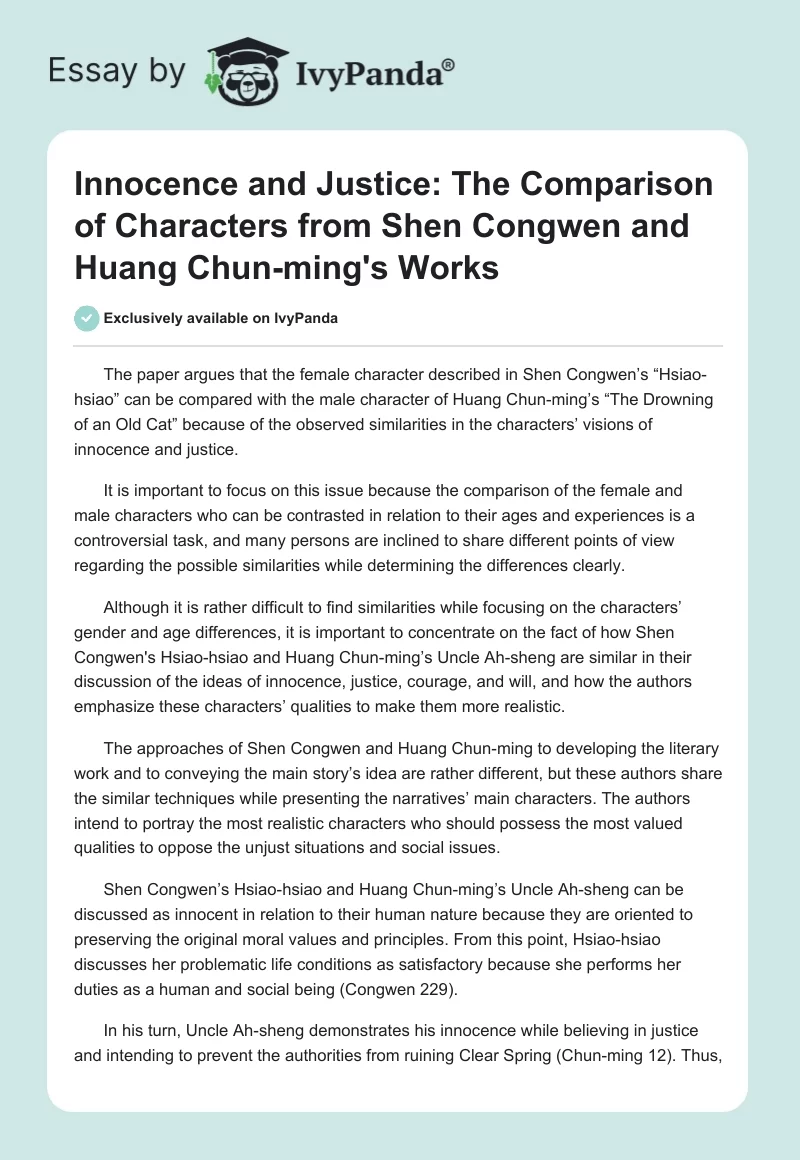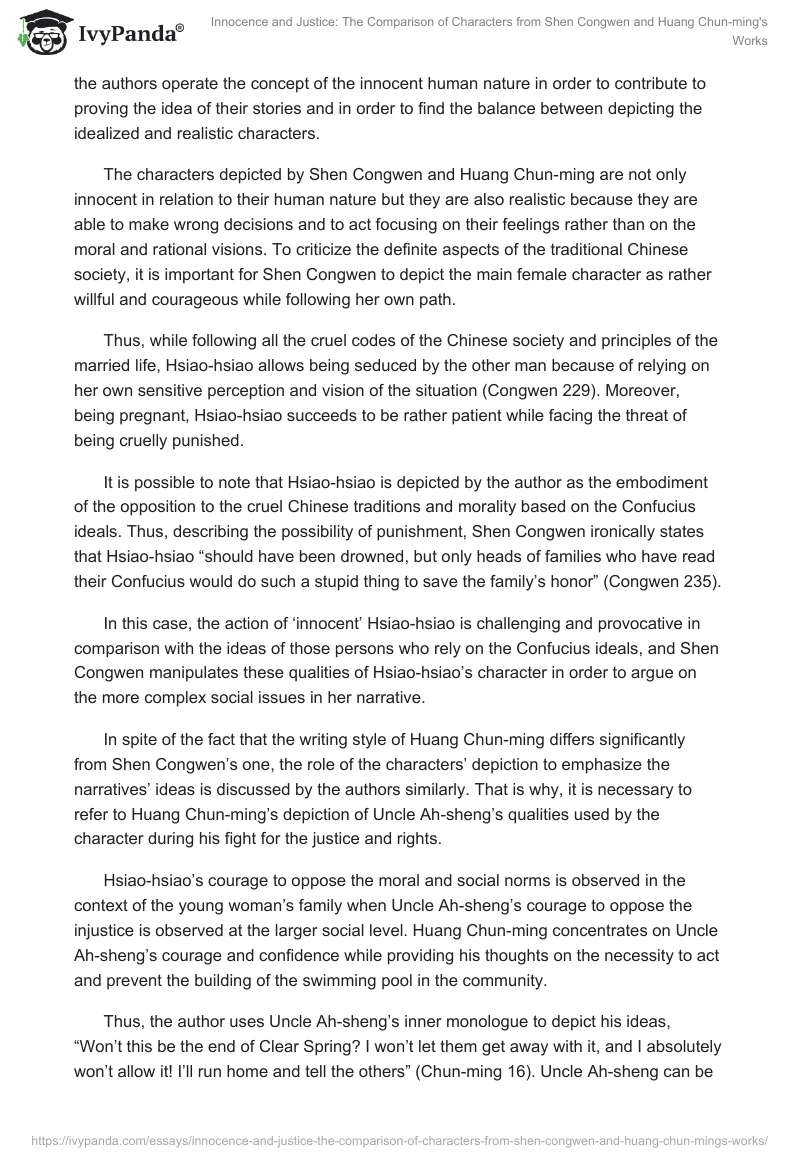The paper argues that the female character described in Shen Congwen’s “Hsiao-hsiao” can be compared with the male character of Huang Chun-ming’s “The Drowning of an Old Cat” because of the observed similarities in the characters’ visions of innocence and justice.
It is important to focus on this issue because the comparison of the female and male characters who can be contrasted in relation to their ages and experiences is a controversial task, and many persons are inclined to share different points of view regarding the possible similarities while determining the differences clearly.
Although it is rather difficult to find similarities while focusing on the characters’ gender and age differences, it is important to concentrate on the fact of how Shen Congwen’s Hsiao-hsiao and Huang Chun-ming’s Uncle Ah-sheng are similar in their discussion of the ideas of innocence, justice, courage, and will, and how the authors emphasize these characters’ qualities to make them more realistic.
The approaches of Shen Congwen and Huang Chun-ming to developing the literary work and to conveying the main story’s idea are rather different, but these authors share the similar techniques while presenting the narratives’ main characters. The authors intend to portray the most realistic characters who should possess the most valued qualities to oppose the unjust situations and social issues.
Shen Congwen’s Hsiao-hsiao and Huang Chun-ming’s Uncle Ah-sheng can be discussed as innocent in relation to their human nature because they are oriented to preserving the original moral values and principles. From this point, Hsiao-hsiao discusses her problematic life conditions as satisfactory because she performs her duties as a human and social being (Congwen 229).
In his turn, Uncle Ah-sheng demonstrates his innocence while believing in justice and intending to prevent the authorities from ruining Clear Spring (Chun-ming 12). Thus, the authors operate the concept of the innocent human nature in order to contribute to proving the idea of their stories and in order to find the balance between depicting the idealized and realistic characters.
The characters depicted by Shen Congwen and Huang Chun-ming are not only innocent in relation to their human nature but they are also realistic because they are able to make wrong decisions and to act focusing on their feelings rather than on the moral and rational visions. To criticize the definite aspects of the traditional Chinese society, it is important for Shen Congwen to depict the main female character as rather willful and courageous while following her own path.
Thus, while following all the cruel codes of the Chinese society and principles of the married life, Hsiao-hsiao allows being seduced by the other man because of relying on her own sensitive perception and vision of the situation (Congwen 229). Moreover, being pregnant, Hsiao-hsiao succeeds to be rather patient while facing the threat of being cruelly punished.
It is possible to note that Hsiao-hsiao is depicted by the author as the embodiment of the opposition to the cruel Chinese traditions and morality based on the Confucius ideals. Thus, describing the possibility of punishment, Shen Congwen ironically states that Hsiao-hsiao “should have been drowned, but only heads of families who have read their Confucius would do such a stupid thing to save the family’s honor” (Congwen 235).
In this case, the action of ‘innocent’ Hsiao-hsiao is challenging and provocative in comparison with the ideas of those persons who rely on the Confucius ideals, and Shen Congwen manipulates these qualities of Hsiao-hsiao’s character in order to argue on the more complex social issues in her narrative.
In spite of the fact that the writing style of Huang Chun-ming differs significantly from Shen Congwen’s one, the role of the characters’ depiction to emphasize the narratives’ ideas is discussed by the authors similarly. That is why, it is necessary to refer to Huang Chun-ming’s depiction of Uncle Ah-sheng’s qualities used by the character during his fight for the justice and rights.
Hsiao-hsiao’s courage to oppose the moral and social norms is observed in the context of the young woman’s family when Uncle Ah-sheng’s courage to oppose the injustice is observed at the larger social level. Huang Chun-ming concentrates on Uncle Ah-sheng’s courage and confidence while providing his thoughts on the necessity to act and prevent the building of the swimming pool in the community.
Thus, the author uses Uncle Ah-sheng’s inner monologue to depict his ideas, “Won’t this be the end of Clear Spring? I won’t let them get away with it, and I absolutely won’t allow it! I’ll run home and tell the others” (Chun-ming 16). Uncle Ah-sheng can be characterized as determined to prevent the destruction of the sacred spring because he ‘absolutely won’t allow it’, and his activities support his decisiveness.
The characters portrayed by Shen Congwen and Huang Chun-ming are also realistic because the authors are inclined to preserve the balance between the demonstration of their righteousness and their obvious weaknesses. Uncle Ah-sheng is as focused on justice as Hsiao-hsiao is focused on finding the right way from the life problematic situations.
Thus, the obvious injustice and violation of the villagers’ rights noticed by Uncle Ah-sheng infuriated him, and he “couldn’t understand why others received the protection of the law for interfering with his and his friends’ actions, while the righteousness of his behavior was considered illegal” (Chun-ming 24).
Referring to these Uncle Ah-sheng’s thoughts, it is possible to state that Huang Chun-ming describes his character as rather self-confident because he expresses few doubts about the ‘righteousness of his behavior’.
These elements accentuated by Huang Chun-ming are correlated with Shen Congwen’s portrayal of her female character because Hsiao-hsiao is inclined to conclude about the righteousness of the other people’s actions and behaviours while referring to her own experience.
However, it is also important to note that, in general, the images of Hsiao-hsiao and Uncle Ah-sheng are quite positive and reflecting the best features of the human nature in order to contribute to the authors’ intentions to depict the realistic situations with involving the realistic characters.
In spite of the fact that in their stories, Shen Congwen and Huang Chun-ming present the female and male characters belonging to different age categories, the authors’ approaches to depicting Hsiao-hsiao and Uncle Ah-sheng are rather similar because of the idea to portray the realistic characters who can oppose to the cruelty and injustice of the society because of their inner power, innocence, feeling of justice, courage, and will experienced in many problematic situations.
Hsiao-hsiao and Uncle Ah-sheng as they are depicted by the authors are not idealized with references to their morality or righteousness, but they seem to be realistic and powerful because of their true human nature which helps the characters be alive and active while struggling against possible injustice.
Works Cited
Chun-ming, Huang. “The Drowning of an Old Cat”. The Taste of Apples. Ed. Huang Chun-ming. USA: Columbia University Press, 2001. 11-31. Print.
Congwen, Shen. “Hsiao-Hsiao”. Modern Chinese Short Stories and Novellas 1919-1949. Ed. Joseph Lau. New York: Columbia University Press, 1981. 227-236. Print.


